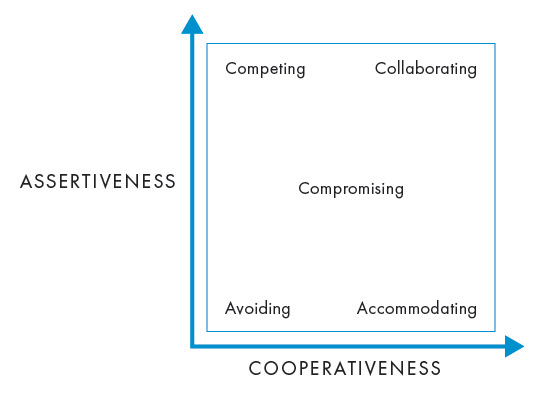
Four Steps to Better Decision-Making
March 1, 2022
Why Are Difficult Conversations So Difficult?
May 1, 2022Don’t Jump! A Better Approach to Effective Conflict Resolution

Do you loathe conflict? If so, you’re not alone. Thirty-five percent of managers would reportedly rather jump out of a plane than address a problem with their team. I’m guessing most would prefer to have a parachute, but some might not!
Before you decide to jump, consider three principles that can help you more effectively resolve the next conflict you encounter: 1) understand the common types and causes of conflict, 2) know when and how to address the conflict, and 3) collaborate to effectively resolve the conflict.
Prior to diving in, think for a minute about a recent, current, or emerging conflict involving one of your team members . . . . Now, let’s unpack it together.
1) Understand the Common Types and Causes of Conflict
There are four basic types of conflict:
- Relationship (personal disagreement or personality clash)
- Task (disagreement about the intended goal)
- Process (disagreement about the means of achieving the goal)
- Status (disagreement or competition around perceived personal contributions or value)
Which category best characterizes the nature of the conflict you’re thinking about?
Next, consider some of the most common causes of conflict in organizations:
- Personality differences
- Conflicting values
- Unclear or overlapping responsibilities
- Limited resources
- Poor communication
- Unrealistic or confusing expectations
- Previous conflicts that have been suppressed
Do any of these sound familiar?
2) Know When and How to Address the Conflict
Now that you have a basic understanding of the type and cause(s) of the conflict you’re dealing with, the next question is: When and how should you address it?
You have three options. First, you could choose to do nothing. This might be the preferred course of action if you realize your limited time requires you to choose your battles, and you assess that the situation is relatively low risk. Second, you could address the conflict indirectly by working through a third party. You might choose this approach for a specific issue or situation where you believe the person would be more receptive to feedback from someone else, such as an outside expert or a trusted confidant. Third, you could address it directly.
Let’s assume you need to address the conflict directly. Here are a few things to consider as you prepare:
- Select a proper time and place to address the issue (privately, one-on-one, when emotions aren’t running high is a good place to start)
- Set your ego aside
- Be ready to listen and seek to understand all of the perspectives involved
- Think about the larger organizational context surrounding the issue
Now, armed with an understanding of the type of conflict and potential root cause(s), and a proper mindset to help you address the issue, you can focus on how to effectively resolve it.
3) Collaborate to Effectively Resolve the Conflict
Six techniques commonly used to manage organizational conflict are:
- Avoiding (ignoring or choosing not to address the issue)
- Accommodating (allowing or enabling the issue to persist)
- Competing (attempting to win at all cost)
- Compromising (making mutual concessions)
- Collaborating (working together to resolve the issue)
- Elevating (punting the issue to higher authority)
Conflict research pioneers Kenneth Thomas and Ralph Kilmann developed a popular conflict-handling model called the “Thomas-Kilmann Conflict Mode Instrument” that incorporates all of these techniques (except for elevating, which is “off the chart” so to speak):

They found that a person’s tendency toward a certain conflict resolution technique depends on a combination of their levels of assertiveness and cooperativeness. The most common techniques – avoiding and compromising – are the result of being simultaneously unassertive and uncooperative. Competing occurs when someone is very assertive, but uncooperative. Accommodating is the result of someone being very cooperative, but unassertive. Where in the “box” do you usually fall when faced with conflict?
Effective conflict resolution occurs when both parties collaborate and work together to resolve the issue. This requires an intentional combination of assertiveness and cooperativeness with a goal of win-win problem-solving.
What are the keys to being assertively cooperative in a professional and tactful way? Focus on your delivery when presenting a different point of view. It’s easy to trigger people into shutting down if you’re not careful, and then the collaboration comes to a grinding halt. Some effective ways to prevent this are to share your perspective without judging others’ intentions, ask open-ended questions to understand the underlying issue(s), and admit that you might be missing something and ask for help understanding.
How will you know when you’ve achieved a good resolution? Ask yourself three questions: Does it satisfy as many interests as possible? Is it fair and reasonable? Are the relationships still intact? If the answer to all three questions is “yes,” then there’s a good chance you’ve collaboratively navigated to a win-win resolution.
The next time you’re tempted to jump out of a plane rather than address a conflict with your team, try this approach instead. By understanding the type and cause of the conflict you’re facing, knowing when and how to address it, and collaborating to effectively resolve it, the sky’s the limit for better conflict resolution!
To dive deeper on effective conflict resolution, check out The Substance of Leadership: A Practical Framework for Effectively Leading a High-Performing Team. Also, take the five-minute Performance Pressure Test for more insight into how well you’re performing as a leader.
